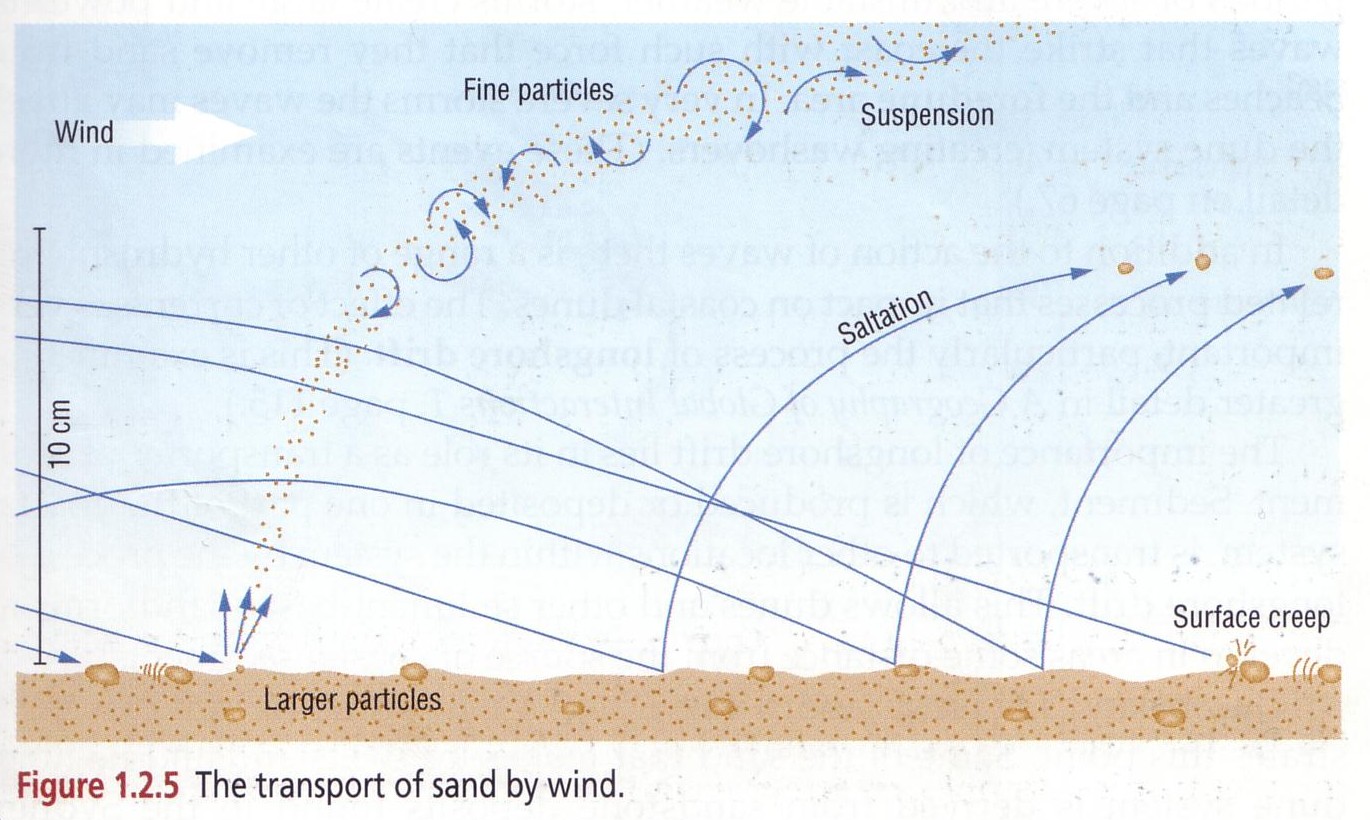
2.3 Weather and Climate
- The atmosphere is a very important biophysical component in Coastal Dune Ecosystems.
- Wind, temperature,and precipitation are key climatic and weather factors that play a significant role in the moving of sand particles in the accretion cycle on Coastal Sand Dunes and in providing the conditions for the vegetation to grow.
Wind
- The single most important factor in determining the shape and extent of Coastal Sand Dunes is wind.Wind helps shape, dry , move, and weather sand.
- Coastal Sand Dunes are most likely to develop in coastal regions that experience strong onshore prevailing winds (wind that blows on to the shore from the sea. For this reason the most extensive dune ecosystems are found in the world's temperate (hot summers cold winters) and arid (dry) tropical climatic zones.
- In the Stockton Bight, where the Dune System is located, the prevailing winds changes from season to season but 75% of the wind is onshore blowing in from the south-east most of the year round.
AEOLIAN TRANSPORT
- Wind is a major contributor to the erosion of Sand particles on dunes but also it plays a role in the movement of sand on dunesin the accretion cycle.
- Sand is moved through three Aeolian Transport processes: Saltation, Creep, Suspension. Figure 1.2.5 below illustrate these processes. If the grain is any larger than around 1 cm in diameter it will be too big for any form of Aeolian transportation.


Saltation
- Have you ever noticed while lying on the beach that tiny sand particles seem to be bouncing around like jumping beans? Well, this is one of the most common ways that sand is moved on Sand Dunes. This bouncing motion is called SALTATION.
- Sand particles are moved in a current of wind by a series of bouncing movements.
- As the wind strikes the ground it causes turbulence, meaning the air moves in several directions. This causes the sand grains to become loosened and easily moved.
- If the wind has enough velocity (speed) it will cause the sand grains to begin moving. The amount of speed necessary to move the sand particles will change depending on how big the particle is, how much vegetation is present and how wet the sand is.
- As the sand grains begin to move along the ground they strike other grains. This collision can cause one or more of them to bounce into the air.
- Once in the air, the grain is moved by the stronger winds that exist higher above the ground surface.
- Gravity soon causes the grain to fall back to the ground. The grains generally strike the surface at an angle ranging from 10 to 16 degrees. This angle is perfect for continued motion, if the grain falls on a rocky or other hard surface it will simply bounce into the air again. Should the grain fall back onto a sandy surface, the falling grain is likely to knock another grain, causing it to bounce and setting off a chain reaction. This reaction eventually sets in motion the entire sand surface.
Surface Creep
- Grains of sand that are too large to be moved by saltation are transported by surface creep.
- Surface creep occurs when the larger grains of sand are dislodged by the impact of falling grains.
- The grains roll along the surface of the ground, being pushed by the smaller falling grains.
- About one fifth of sand movement is caused by surface creep.
Suspension
- Very tiny particles of sand are most commonly moved by suspension.
- In this process the particles are carried by the wind, often well above the ground. They are too small to be influenced by gravity and they may travel for thousands of kilometres before they finally return to earth, often as the nuclei of a raindrop.
- This type of transport is most commonly seen in vast dust storms that occur in arid regions, but it does account for a small proportion of sand moved along coastlines.
Temperature
Temperature affects the drying of the sand and the ability for vegetation to be present
Precipitation
The amount of Precipitation determines how wet the sand gets and assists in the ability of vegetation to grow.
- Precipitation influences the vegetation cover, which helps stabilise the sand on Coastal Sand Dunes. Thus, it plays a role in the storage of sand in the accretion cycle.
- Furthermore, heavy rainfall can erode steep dune faces but the wet sand is less prone to erosion by wind. Thus, playing a role in the removal of sand in the accretion cycle.
- In the Stockton Bight area,the proximity to the sea allows for precipitation to be spread evenly through the year.
- The wettest months are January to June, especially March. The most intense falls occur in summer storms. The average rainfall in the Hunter Region is 737 mm and 1328 mm at Port Stephens. Precipitation at the Bight varies from 1000 mm near the Hunter River to 1300 mm in the east.
- Enough precipitation is present in the Stockton Bight area to assist in the formation of dune vegetation.
- Furthermore, precipitation it is not constant and heavy enough (like in the tropics) to make the sands constantly wet. Thus, the accretion cycle can function properly as the precipitation provides the moisture needed for the vegetation to help store sand, and the sand is not constantly wet to stop the movement of it by the wind, but enough precipitation also comes to slow the Aeolian transport during some parts of the year.